The Ruger 10/22 is a semi-automatic rimfire rifle that was introduced in 1964 and was chambered in .22 Long Rifle. As popular then, as it is now, the Ruger 10/22 has almost a religious following among adults, has served as a friendly youth rifle, and continues to serves as a customization donor for many.
While I am not a 10/22 follower, I do own two Ruger 10/22 firearms; the basic standard unit with a black synthetic stock and a (discontinued) International model with a full Mannlicher-style wood stock. The standard unit has been topped off with a scope and has received the Ruger BX trigger unit. The “International” model has received no changes. Unlike many who have succumbed to the Ruger 10/22 customizing fever, I only made changes that made the firearm “usable” as a general plinking tool and fun shooter.
Lately, I had the desire for a good “Target” grade rifle in .22 Long Rifle caliber, which meant that I wanted a heavy barrel version that would be suitable for target shooting, hunting (if necessary), and Project Appleseed use. I searched through many manufacturers specimens on the WWW and somehow would up focusing on the Ruger 10/22 Target; Model 1262.
While I have other .22 caliber rifles, including a marlin Model 60, I felt that the Ruger 10/22 Target would best suit the needs for timed fire in a Project Appleseed course that I intend to attend this next year. Even the Appleseed Project recommends a semi-automatic firearm over a bolt-action (of which I have several), because a bolt-action rifle may not be cycled fast enough for the timed events, let alone making fast magazine changes. It would seem that the Appleseed Project was developed with the Ruger 10/22 in mind, or the other way around.
Ruger currently offers the 10/22 Target in two configurations; carbon steel with brown laminate furniture, or stainless-steel with black laminate furniture. I liked both, but could only have one. My choice was the stainless-steel with black laminate furniture version. Although the furniture is eye-candy, I would have preferred the stainless-steel version with brown laminate furniture, simply because I am an earth person and I like the warm look of brown. But, this was a case of getting what I needed rather than getting what I wanted.
According to Wikipedia, the Ruger 10/22 is a rifle, although that may be argued due to the length of the barrel. The Ruger 10/22 Target; however, fits the definition of a rifle with a 20” barrel.
I did a lot of research for the Ruger 10/22 Target, but I actually found little in the way of a review. Most articles and videos regarded the customization of the rifle rather than focusing on the pros and cons of the rifle as it is delivered to the customer. I hope to address the latter in this review.
THE BASICS:

Figure 1 – Ruger 10/22 Target (Model 1262)
The information that follows is provided by Ruger.

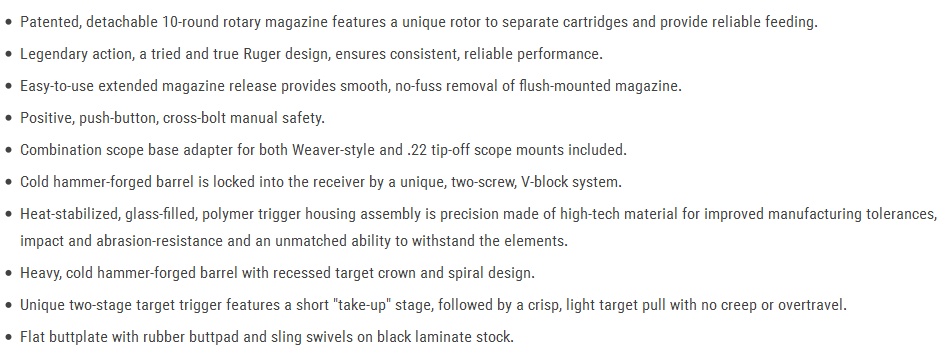
Actually, there is not a lot to learn from the basics; however, there are differences with the “Target” model that does separate it from the “Basic” carbine version and those differences is what I wish to transmit to you with this review.
THE LOCK:
The “lock” consists of the usual Ruger trigger module that incorporates the firing mechanism, safety button, magazine release, and bolt lock features.
According to Ruger, the 10/22 Target model has the following features:
- Heat-stabilized, glass-filled, polymer trigger housing assembly is precision made of high-tech material for improved manufacturing tolerances, impact and abrasion-resistance and an unmatched ability to withstand the elements.
- Unique two-stage target trigger features a short “take-up” stage, followed by a crisp, light target pull with no creep or over-travel.
While this all sounds nice, I needed to know how the trigger compared with the Ruger trigger that is standard to the 10/22 and the Ruger BX trigger that can be purchased separately. Having installed the Ruger BX trigger in my 10/22 carbine and Ruger Charger, I had something to compare with and would base the comparison on the features of the BX trigger. The result of the comparison is shown below.

The trigger incorporates the same style push-button safety as other 10/22 models, which is mounted just in front of the trigger guard. As usual, the safety button is pushed left to fire, which is not friendly to “lefty” shooters like me and Ruger does not make a left-handed version of the 10/22. I just use the thumb of the right hand to push the safety off-safe.
If you are familiar with the 10/22, the magazine release lever and bolt lock are in their usual places and operate in the same fashion.
True to the Ruger’s usual fashion with the 10/22, the bolt does not lock back on the last round and the bolt lock does require some dexterity to use – even to shooters experienced with the 10/22.
Ruger issues the following warning regarding the Target trigger:
SPECIAL SAFETY NOTE
10/22® TARGET RIFLE ONLY
The special model you have selected is specifically designed for rapid fire precision target shooting. As such, it demands that you take extra safety precautions.
The trigger of the Target version of the RUGER® 10/22® has a lighter, target trigger pull than standard 10/22® rifles and carbines, for more precise placement of shots. You should practice “dry-firing” an empty rifle (with it pointing in a safe direction) to learn the “feel” of the trigger before ever loading it with ammunition.
As with all Ruger 10/22 firearms, the use of “Stinger” ammunition is highly discouraged, and it seems, especially with the Ruger Target model. In addition, do not use 22 short, 22 long, 22 shot, or 22 cartridges loaded with blunt-nosed, sharp-shouldered, or “explosive” bullets.

Figure 2 – Ammunition Warning
No changes to the receiver and receiver components have been made; the trigger, stock, and barrel seem to be the only things that set the “Target” model apart from other models.
The Ruger 10/22 Target utilizes the same rotary magazines as other 10/22 firearms and the rifle is shipped with one 10-round magazine. The Ruger magazine was also an influence in my purchasing this rifle – I don’t have to worry about buying magazines that only work in one rifle.
THE STOCK:
I have the Ruger Gunsite Scout with black laminate furniture, and I expected that the stock on the Ruger 10/22 Target would be similar in depth and pattern. In reality, the stock is much darker, but does have a nice texture. Some mild blemishes exist in the finish, but it is difficult to tell if the blemishes were from handling or occurred during the finishing process. Overall, the black laminate stock looks nice and is to a quality expected from a production rifle. A thin clear satin layer is applied for looks and protection.
The stock has a 13 ¾” LOP, which is a good stock length for most people. Although I find the LOP a tad short for me; however, with the scope setup that I have (see, PREPPING FOR SHOOTING), the existing LOP seems to work well. An after-market slip-on recoil pad will provide a longer LOP if need be.
Front and rear 1” wide non-swiveling Sling loops are provided with rifle. I really would have preferred that Ruger simply provided sling points that would have allowed the use of a bipod attachment. I think that Ruger might have had the Appleseed Project in mind with this feature, where using a sling is a must, but for a target rifle the use of a bi-pod is highly desired – at least by me. Fortunately, the front sling mount is a screw-in feature and I can substitute the existing sling mount with one more to my liking.
The butt of the stock is squared-off, unlike the stocks on standard 10/22 rifles. There is a 1/8” spacer of (what seems to be) polymer material followed by a soft rubber butt-pad that really grips the clothing. The butt pad measures approximately 1.5” wide x 5.125” long in case you decide to buy the Ruger 10/22 Target, and like me, want to add a slip-on butt pad for extra LOP.
THE BARREL:
The 20-inch, 6-grove, 1:16” RH twist Target barrel contributes heavily (no pun intended) to the 7.5 pound weight of the rifle.
As with all Ruger 10/22 barrels, the two-screw V-block system holds the barrel firmly to the receiver.
The brushed stainless-steel exterior of the barrel is finished in a spiral pattern the length of the barrel. At first appearance, the spiral pattern seems to be lightly applied, but the barrel has a spiral pattern that you can feel. There were, in several places along the barrel, cosmetic flaws. Like the stock; however, it is difficult to tell if these flaws were from handing or occurred during the manufacturing process. Again, the Ruger 10/22 target model is production piece and is not without its flaws. The flaws; however, are not deal breakers for me. I am sure that over time and handling, I will be adding my own marks and scratches. I am not sure if the carbon steel barrel finish would be any better protection against wear and tear.
The barrel is a Ruger Hammer Forged barrel. I know that for a fact because, that statement seems to be laser etched into a flat area milled on top of the barrel. With a scope mounted atop the receiver, you would not know this inscription exist, because a scope covers most of this area, but it does exist. On the underside of the barrel is another flat, milled area with the “Read Instruction Manual Before Using Firearm” and “Ruger, Newport NH, USA” laser-etched.
A recessed target crown keeps the muzzle protected.
No provision for fixed sights is provided.
Ruger provides some information in the manual for the care of stainless-steel:
MAINTENANCE OF STAINLESS STEEL RIFLES
Firearms and components made of stainless steel are relatively more resistant to corrosion than those of blued steel. However, in the interest of proper operation and long life of a stainless steel firearm, inspect it frequently and clean, lubricate and apply an appropriate rust preventative.
Sometimes discoloration occurs from perspiration or from contact with some types of gun cases. Rusting may occur as a result of the firearm being exposed to moisture, salt air or chemicals.
Minor discoloration can usually be removed by rubbing the stainless area with an abrasive ink eraser, crocus cloth, or a “metal polishing” compound. When using any of these abrasives, proceed with care and use light pressure to achieve a blending of “color” with those areas that are not discolored. Do NOT use abrasives on the clear coating of the aluminum alloy receiver and trigger housing.
External surfaces most subject to rusting from handling, or from exposure to the elements, should be cleaned and wiped dry after use or after exposure to adverse conditions. If the rifle is to be stored, coat it with a light film of oil or preservative. Where the rifle is in continuing use, and the presence of oil or grease would be objectionable, then the external surfaces can be coated (after
cleaning and drying) with a paste wax formulated for use on metals. Apply the wax sparingly, allow time for it to dry hard, then buff lightly with a soft cloth. When applying the wax, take care that it does not get into the mechanism or on the functioning parts or in the bore.
PREPPING FOR SHOOTING:
The Ruger 10/22 Target model is not a rifle that you can simply take out of the box and expect it to hit anything resembling a target with any degree of accuracy. The firearm requires an optic to be mounted – magnified or otherwise.
I selected a Nikon PROSTAFF Rimfire II 3-9×40 rifle scope, since I have peered through one like it that was mounted on a .22 caliber Anschutz rifle owned by my favorite shooting companion, and have also mounted a Nikon PROSTAFF Rimfire II 4-12×40 on the Ruger American Rimfire 22LR. The Nikon PROSTAFF Rimfire II 3-9×40 is simply a better unit for my indoor endeavors, but can be used for longer distance shooting should I get to move outdoors with the rifle or at an indoor range with 100-yard capabilities.
Since Ruger provide the sight base, and its finish matches the receiver, I decided to go with it. Ruger ships a Weaver-style rail with an integrated conventional 3/8” dovetail, which leaves the scope mounting choice up to the user. I selected the Weaver-style portion of the base due to its more stable platform. Some assembly; however, is required prior to mounting the scope. Ruger provides instructions for mounting the bases in the Instruction Manual that comes with the firearm. Note that a torque screwdriver, like “The Fat Wrench” is required to apply the correct amount of torque to the base mounting screws. The last thing that you need is to snap off a mounting screw during assembly. Sight base screws are to be tightened between 15 to 25 inch pounds, according to Ruger.
A set of matte finish, Leupold 1” Rifleman Detachable Rings with a medium height would do the duty of securing the Nikon PROSTAFF Rimfire II 3-9×40 scope to the receiver. The “medium” height rings place the center of the scope perfectly at my eye level with a proper cheek weld and also provides plenty of barrel clearance for the 44mm objective lens housing. The scope was set for eye relief, leveling was performed, and all screws were torque to 15-inch pounds. With the Ruger 10/22 Target model, recoil is definitely not an issue.
To put things into perspective, the Ruger 10/22 Target model, with the PROSTAFF Rimfire II 3-9×40 rifle scope, weighs in at roughly 8.32 pounds, which is roughly 1.5 pounds less than a Springfield M1A with a walnut stock. Add another nine or so ounces for a bi-pod and you have a robust firearm platform.
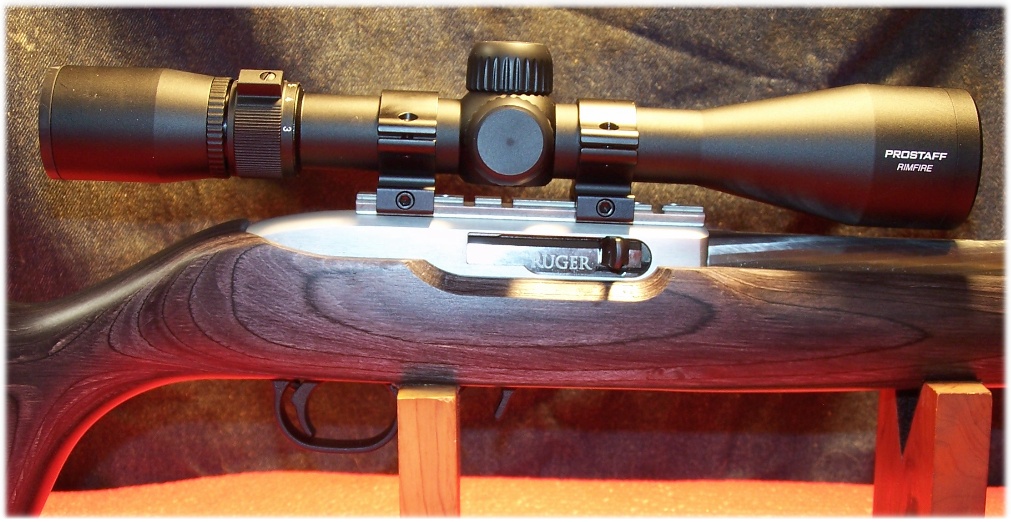
Figure 3 – PROSTAFF Rimfire II 3-9×40 rifle scope w/BDC
RANGE TIME:

Figure 4 – Center circle shot with 10-rounds of Federal AM-22, 40-grain @ 25yards. Circles measure 1.0″ o.d. x 0.5″ i.d.
Since the Ruger 10/22 Target model is supposed to be, well, a target rifle, Federal AM22 Target Grade Performance ammunition, a 40-grain projectile rated at 1200fps, was going to be the cartridge of choice.
Granted that twenty-five yards was not going to be even close as a test for this rifle, but it had to do for the time being.
A 100-yard sight-in target was sent to twenty-five yards distant. Since I had not bore-sighted the rifle, I had no idea where points of impact would be. Once established, and once zero was finalized at twenty-five yards, I could then play with some seriously small targets, fine-tune the zero, and hopefully give my shooting companion and his Anschutz 22LR a run for his money with some friendly competition.
The accompanying image (Figure 4) shows the result of firing 10 rounds of Federal AM-22, 40-grain “target grade” ammunition into the center circle at twenty-five yards; the best of three groups. The other groups were not much different from this one.
The trigger seemed to be smoothing out by the end of the session, but since it is not yet broken in, it remained a point of contention throughout the session. The trigger face is wide, slightly rounded in shape, and serrated to help keep the shooting finger in place. The break was clean and unpredictable, but contrary to Ruger’s claim of no over-travel, a slight bit was detected. Overall, I would rate the trigger as good. Hopefully, use will make it better or a Ruger BX trigger unit will be installed.
On a positive note, there were absolutely no FTFs, FTEs, or other mishaps with the rifle or the three 10-round rotary magazines used during the session. The Volquartsen Automatic Bolt Release and Power Custom Competition Extended Magazine Release Ruger 10/22 Aluminum with silver finish worked perfectly (see, IMPROVEMENTS).
OVERALL IMPRESSION:
Overall, the Ruger 10/22 Target (Model1262) is an impressive piece of work. Although true to the 10/22 family of firearms, the “Target” model takes it one step further in providing the 20” inch bull barrel and a much better trigger that is found on the standard 10/22, although it could be argued if the trigger is better or worse than the BX trigger.
If you are used to the Ruger 10/22 Carbine, the Ruger 10/22 Target will feel like a behemoth piece of weaponry to you. While the bull-barrel is a heavyweight, and contributes to the “barrel heavy” feel of the rifle, the laminated stock contributes to a more balanced feel of the rifle due to its weight and design. When shouldered properly, the rifle feels somewhat well-balanced but not as well balanced as the 10/22 Tactical with its shorter barrel.
I will say that the Ruger 10/22 Target is not a rifle that I would want to carry around with me in the woods for any length of time. However, if I needed to put a lot of round downrange in a short period of time, I would choose this rifle over a standard 10/22 carbine.
I would have liked for Ruger to have pre-installed the sight base. While installing it is not a problem for somebody with any modicum of experience in doing so, installing it does take some care and proper tools. I find the provided sight base adequate, but there are some who would prefer a different sight base (for example, a 1913 Picatinny rail), and I understand that. But, for the most of us, a pre-installed sight base would be a time (and aggravation) saver.
IMPROVEMENTS:
While I would have preferred that Ruger included standard sling mounts, I have no qualms with the provided 1” sling loops and I will find a nice black leather fully adjustable sling to use with the rifle.
An extended magazine release lever has been installed. I have these on my Ruger 10/22 Carbine and the Ruger Charger. An extended magazine release lever definitely makes magazine changes easier and faster, and it fully protects the trigger guard from damage. I decided on the Power Custom Competition Extended Magazine Release Ruger 10/22 Aluminum with silver finish, since the silver will match the receiver and would accent the overall stainless/black theme of the rifle. The unit also has a cutout that allows full engagement with the bolt release lever.
The bolt lock/release lever was also changed out to an extended one that makes locking and releasing the bolt a pleasure rather than a chore. Having used one before, the Volquartsen Automatic Bolt Release Ruger 10/22 is a good choice, in my opinion.
One of the most common improvements for the Ruger 10/22 is replacing the steel bolt stop pin with one from Tuffer Buffer or Volquartsen. I have these installed in my Ruger 10/22 carbine and Charger. A bolt buffer definitely makes the 10/22 a quieter running machine, protects the bolt and receiver housing, and since it replaces the steel bolt stop pin, the bolt travel distance during operation is not affected. To me, bolt buffers are a welcomed upgrade. Operational life of the buffer is about 10,000 rounds, or so I have read.
All of the above enhancements can be DIY, and instructions for installing extended controls are available on the WWW, but some may decide to use the skill and knowledge of a qualified gunsmith.
From my standpoint, the above are the only upgrades that I feel necessary. Of course, no upgrade will be made until a rifle is deemed worthy of such upgrades. You just don’t reward a rifle if it behaves badly, after all. Some; however, would consider the Ruger 10/22 Target as a donor for a custom build. But, aside from a few minor improvements, I am satisfied with the visual appearance and the performance of the rifle out of the box.
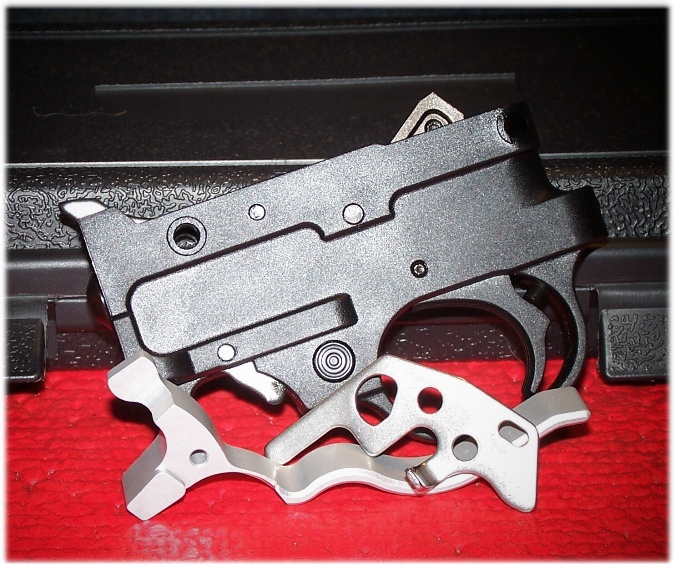
Figure 5 – Power Custom Competition Extended Magazine Release Ruger 10/22 Aluminum and Volquartsen Automatic Bolt Release Ruger 10/22 Upgrades
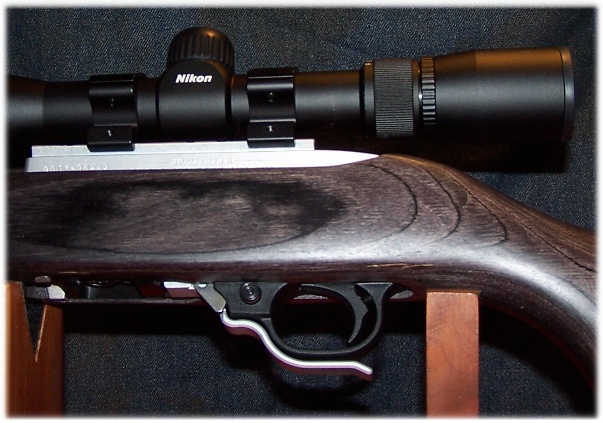
Figure 6 – Upgrades Fully Installed
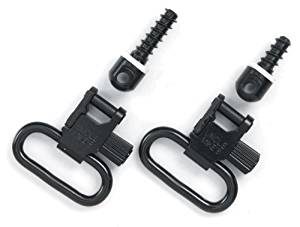
Figure 7 – Uncle Mike’s QD 115 RGS Bolt Action Wood Screw Type Sling Swivels (Blued, 1-1/4-Inch Loop)
One upgrade was made to the sling system. The sling loops that come with the rifle are for a 1-inch sling, which I felt was too narrow for the bulk of this rifle. Also, the original sling mounts do not allow for a bipod attachment. The Uncle Mike’s QD 115 RGS Bolt Action Wood Screw Type Sling Swivels (Blued, 1-1/4-Inch Loop) replaces the original units. The mounts allow me to add a bipod up front.
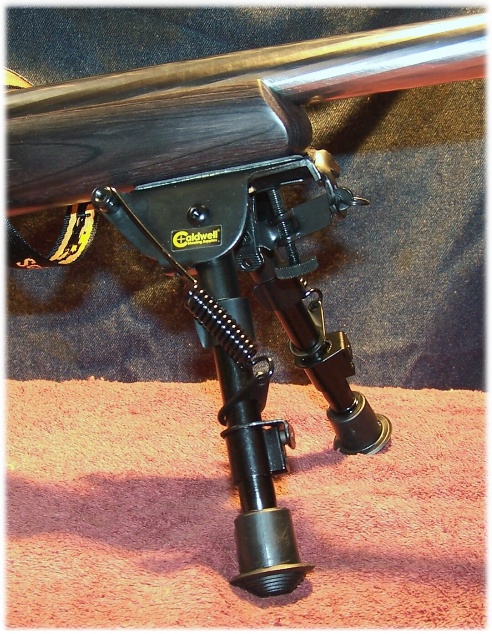
Figure 8 – Caldwell Bipod All Set Up!
The bipod is an inexpensive Caldwell XLA 6-9” unit that has served me well in the past. I have simply added two strips of soft Velcro to the center of the unit to provide (I feel) more adequate protection for the stock. The bipod also allows me to mount a sling.
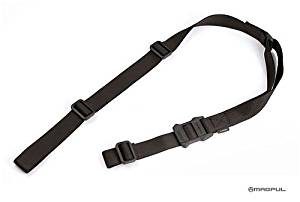
Figure 9 – Magpul Two Point Sling – Quick Adjust (Black)
I originally ordered two different slings for the rifle; a M1 Garand Rifle Sling, Cotton Web, Black, w/ Parkerized Hardware and a Magpul Two Point MS1 Sling – Quick Adjust – Black, because I really did not know which sling would work for me. As it turns out, the MAGPUL Two Point MS1 Sling is the better choice. The clip used with the M1 Garand Rifle Sling, Cotton Web, Black, w/ Parkerized Hardware sling fits too loosely with the rear sling loop. The MAGPUL Two Point MS1 sling can be easily adjusted to various shooting positions once the primary adjustment point is established. I’ll have a separate review on the MAGPUL Two Point MS1 Sling at a later time.
PUTTING AN END TO ALL OF THIS:
The Ruger 10/22 is just a fun firearm, regardless of the configuration, to enjoy. It provides an excellent means to introduce new shooters, regardless of age, to rifle marksmanship while serving the experienced hunter with a tool to bring home small game, and the precision shooter for obtaining some high scores. For the Appleseed Project, the Ruger 10/22 is an excellent tool to use for the course.
The Ruger 10/22 Target is a fine rifle out of the box, but a few minor upgrades make the rifle a little more fine a rifle to work with.
RESOURCES:
- Ruger 10/22 Target (Model 1262): http://ruger.com/products/1022Target/specSheets/1262.html
- Power Custom Competition Extended Magazine Release Ruger 10/22 Aluminum: http://www.midwayusa.com/product/1500160459/power-custom-competition-extended-magazine-release-ruger-10-22-aluminum#
- Tuffer Buffer: http://www.tufferbuffer.com/
- Volquartsen Automatic Bolt Release Ruger 10/22: http://www.midwayusa.com/product/928688102/volquartsen-automatic-bolt-release-ruger-10-22#pr-header-back-to-top-link
- Uncle Mike’s QD 115 RGS Bolt Action Wood Screw Type Sling Swivels (Blued, 1-1/4-Inch Loop): https://www.amazon.com/gp/product/B0009TTROW/ref=od_aui_detailpages01?ie=UTF8&psc=1
- M1 Garand Rifle Sling, Cotton Web, Black, w/ Parkerized Hardware: https://www.amazon.com/gp/product/B00OQTMQMQ/ref=od_aui_detailpages00?ie=UTF8&psc=1
- Magpul Two Point MS1 Sling – Quick Adjust – Black: https://www.amazon.com/gp/product/B00JAI14FI/ref=od_aui_detailpages01?ie=UTF8&psc=1
![]()


2 Responses to Ruger 10/22 Target (Model 1262) – Product Review